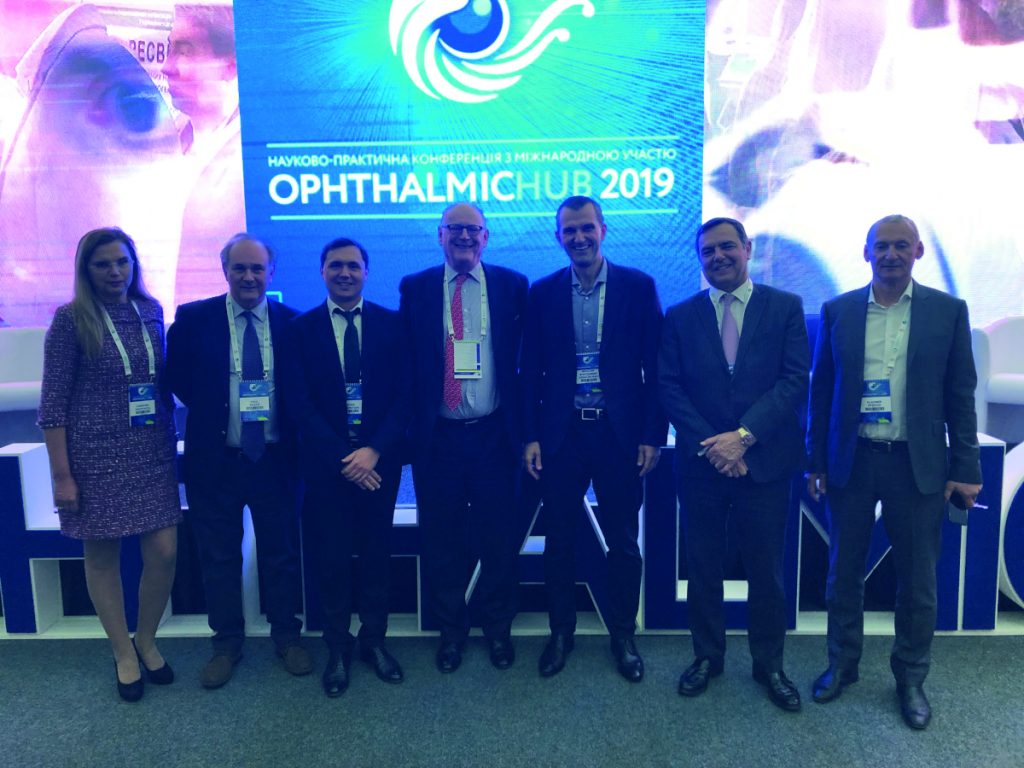New techniques
ESCRS Academy meets in Kiev

Cédric Schweitzer
Published: Wednesday, April 24, 2019
 Distinguished speakers at the ESCRS Academy in Kiev[/caption]
Following the invitation of Professor Oksana Vitovska, the current president of the Ukrainian Alliance of Ophthalmologists, and Dr Volodymyr Melnyk, an ESCRS Academy was organised at the annual meeting in Kiev (15-16 March 2019). The meeting covered the latest topics of cataract and refractive surgery and two sessions were run by the ESCRS Academy.
Ukraine is a large country of Eastern Europe with approximately 40 million inhabitants and nearly 4,000 ophthalmologists. Since the recent tightening of the relationship between Europe and Ukraine, Ukrainian ophthalmologists have developed close educational programmes with European societies to provide the best standard of care for patients.
Before the official meeting, an interactive discussion meeting was organised on March 14 between ESCRS Academy members and representatives of young Ukrainian ophthalmologists to share teaching experience of residents across Europe and give some advice to take benefit of available educational programmes and to optimise the learning process in ophthalmology.
The plenary symposium of the ESCRS Academy was organised on the March 15. I gave a talk on the newest minimally invasive glaucoma surgery techniques associated with cataract surgery. Then, Prof Miguel Teus discussed indication and surgical techniques to improve alignment of toric intraocular lenses and to optimise refractive outcomes of patients following cataract surgery.
Cataract surgery performed in eyes with poor corneal endothelium can be challenging and preoperative or postoperative management was proposed by Prof Christina Grupcheva. Prof David Spalton gave a talk on exfoliative syndrome from the pathophysiological process leading to the formation of exfoliative materials to the management of cataract surgery in such difficult cases.
Dr Paul Rosen provided the latest recommendations following a dropped nucleus in cataract surgery and, finally, Dr Vladimir Pfeifer talked about available surgical techniques of intrascleral haptic fixation.
The following day, a video session of “dilemmas in cataract surgery” was run and issues that can be currently observed during surgery were discussed interactively between ESCRS Academy members and the audience.
This ESCRS Academy was a great experience and another opportunity to share the most recent recommendations in cataract and refractive surgery with participants and to meet our colleagues from Ukraine.
Distinguished speakers at the ESCRS Academy in Kiev[/caption]
Following the invitation of Professor Oksana Vitovska, the current president of the Ukrainian Alliance of Ophthalmologists, and Dr Volodymyr Melnyk, an ESCRS Academy was organised at the annual meeting in Kiev (15-16 March 2019). The meeting covered the latest topics of cataract and refractive surgery and two sessions were run by the ESCRS Academy.
Ukraine is a large country of Eastern Europe with approximately 40 million inhabitants and nearly 4,000 ophthalmologists. Since the recent tightening of the relationship between Europe and Ukraine, Ukrainian ophthalmologists have developed close educational programmes with European societies to provide the best standard of care for patients.
Before the official meeting, an interactive discussion meeting was organised on March 14 between ESCRS Academy members and representatives of young Ukrainian ophthalmologists to share teaching experience of residents across Europe and give some advice to take benefit of available educational programmes and to optimise the learning process in ophthalmology.
The plenary symposium of the ESCRS Academy was organised on the March 15. I gave a talk on the newest minimally invasive glaucoma surgery techniques associated with cataract surgery. Then, Prof Miguel Teus discussed indication and surgical techniques to improve alignment of toric intraocular lenses and to optimise refractive outcomes of patients following cataract surgery.
Cataract surgery performed in eyes with poor corneal endothelium can be challenging and preoperative or postoperative management was proposed by Prof Christina Grupcheva. Prof David Spalton gave a talk on exfoliative syndrome from the pathophysiological process leading to the formation of exfoliative materials to the management of cataract surgery in such difficult cases.
Dr Paul Rosen provided the latest recommendations following a dropped nucleus in cataract surgery and, finally, Dr Vladimir Pfeifer talked about available surgical techniques of intrascleral haptic fixation.
The following day, a video session of “dilemmas in cataract surgery” was run and issues that can be currently observed during surgery were discussed interactively between ESCRS Academy members and the audience.
This ESCRS Academy was a great experience and another opportunity to share the most recent recommendations in cataract and refractive surgery with participants and to meet our colleagues from Ukraine.